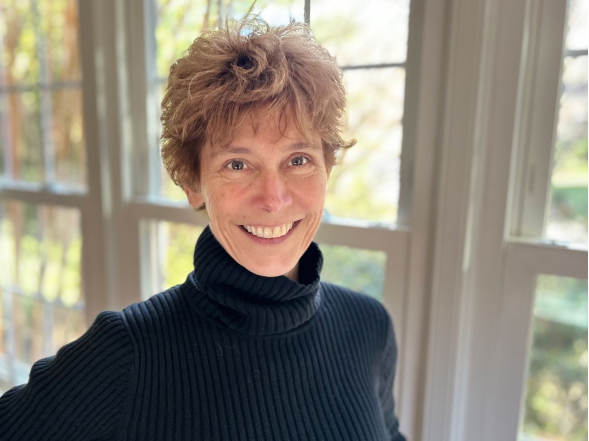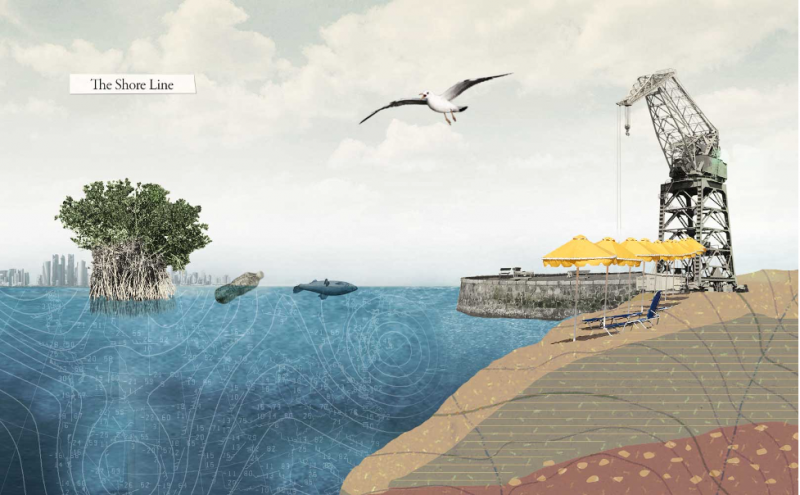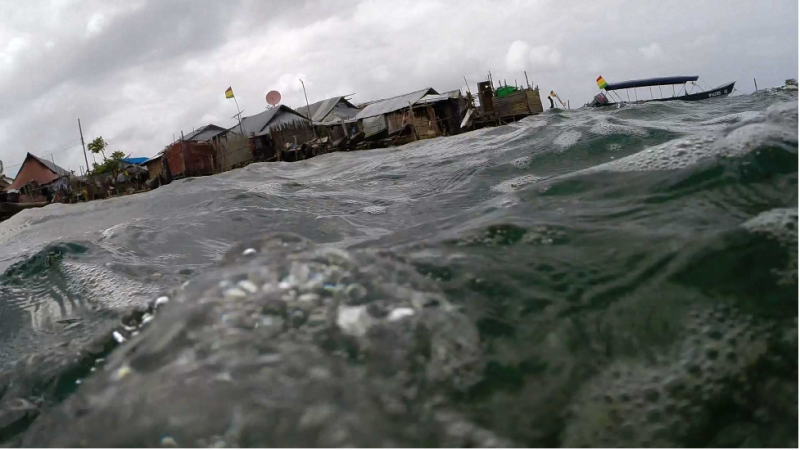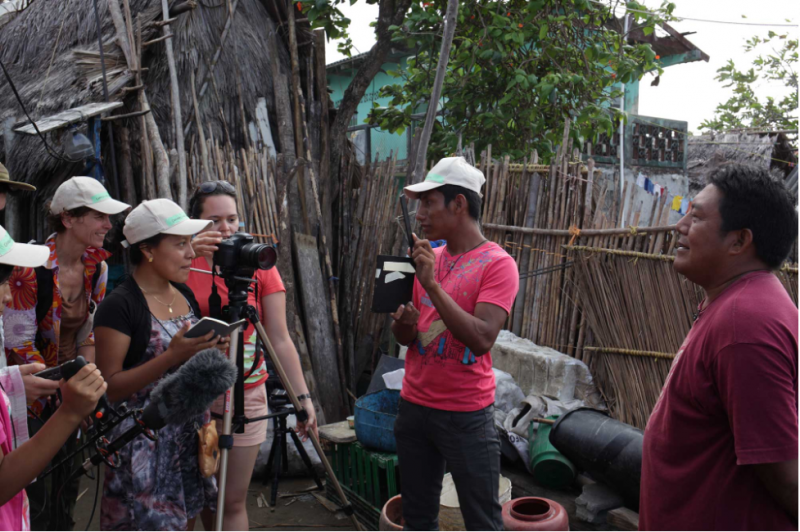
Liz Miller is a documentary maker, scholar, and professor interested in new approaches to community collaborations and documentary as a way to connect personal stories to larger social concerns. Years of experience in community media and a background in political economics and electronic media art fuel her explorations of new media as art, advocacy, and as a powerful educational tool.
Liz is a Full Professor in Communications Studies at Concordia University in Montreal and her documentary projects on issues such as climate change, refugee rights and the environment have won international awards, screened on television, streamed on Netflix, been integrated into global curricula, and influenced decision makers. She is the co-author of Going Public: The Art of Participatory Practice, a book and website that draws on the expertise of creative practitioners across theatre, communications, and history.
Can you describe the Shore Line Project?
The Shore Line is an open documentary project about rising sea levels and unchecked development that uses the coast as a thematic thread. We sought out people who are living along our global coast and confronting challenging situations with collective responses. I use the term open documentary (coined by Patricia Zimmerman and Helen De Michiel) because it’s a project that has an “open narrative structure” and is also free and accessible to anybody with an internet connection. The creation of this documentary was collaborative, and many of the 42 short films within the project were developed by students or international filmmakers from nine different countries.
When you open up each chapter, there’s a soundscape, a series of films, interactive maps and data visualizations. And then we have a searchable database that is particularly important for teachers who might want a feature a particular country, topic or activity. And then we have action kits that feature classroom activities and social actions.
I see the project as a multi-layered tool kit on climate literacy. It offers different ways to experience the material and different ways of learning and thinking.

What was the mode of engagement in the shoreline project?
There were many different modes of engagement throughout the project, from the creation stage, to the distribution of the project, and then eventually to a Participatory Planning Tool.
When I describe this project to people who aren’t in the documentary field or aren’t thinking about modes of engagement or participation, I describe the project as a storybook for the future. It uses our global coast as a topic and a metaphor. Most of us have a relationship to a shoreline. And the idea was to feature people who live at the forefront of dramatic environmental changes, and how they are coming together in collective ways to resolve very complex problems.
Sometimes I use the term solution-based storytelling to describe the project, although so many of us feel like that’s a hard word to use when our problems are so complicated and there are no real solutions. But rather than focus on trauma, we were really looking for individuals responding with creative collective resilience to complex problems related to rising sea levels. I’ll give you an example. I had a student who was in South Africa and she wrote me: “We have graveyards that are disappearing because the water’s rising and community members are really upset.”
The story she had encountered was strong in communicating the devastating impact of rising waters on sacred places that will be lost, places of collective mourning and grief. But when I asked her: “Well, what is the community doing? How are they responding? And she said, “They are freaking out and still trying to deal with the tragedy.” Together we decided not to follow this story, because the community was suffering and we didn’t want to feature just the pain, but also the creative response.

And when a story is created, is it usually put together by the community in a collective form?
The method of sharing a story depended on the social context. For example, there is one community we worked with, an Indigenous community in the Guna Yala archipelago (also known as the San Blas Islands in Panama) where we felt the methodology of that story needed to be co-creation – or should emerge from the community. So basically, we did media workshops with the youth on the island to help them determine the story. Before arriving there, we had done research about the islands and we knew they were in the midst of planning to relocate to higher grounds because of rising seas. They had initiated this really thoughtful and intricate process of involving Indigenous architectural consultants to help plan and consider what it would mean to be displaced, and how they could transfer cultural and architectural traditions to a new home. We imagined that was the story the community would want to tell. But when we got there, we obviously wanted to lead from their own concerns. And the youth we were working with were concerned about the trash lapping up on the shores of the coast and so we worked with the youth to film and share this story of trash.

What is the transformational change you wish to initiate with your practice and with your project?
So, I’ve been teaching at Concordia University in Communication Studies for just about 20 years. And I’m deeply invested in using the classroom as a site of transformation. Early on in my career as an educator, I was speaking to an activist friend, voicing some concerns about feeling removed from social change. And he laughed and he said, “You don’t even have to work at recruiting audiences. You have 20 to 200 people who show up for your class, so your challenge is how to make the best use of a classroom.” And he was right.
And that’s when I really started thinking deeply about how to bring a transformative ethic and logic into a classroom. I realized that I had to address complex issues but also bring hopeful scenarios for social change into the classroom. I wanted to use the classroom as a site of rehearsal where students could think together, resolve conflicts, imagine futures, learn what it means to collaborate. Together we might work through messy, complicated processes, and understand that they’re worthwhile, even if they’re frustrating at times. There’s an Indigenous climate scholar, Kyle Powys Whyte , who talks about the need to bring participatory ethics into the classroom and this is what I wanted to practice.
And that’s why I made The Shore Line because I felt like I needed these capsules of hope about the power of collaborative endeavors. And I wanted to use these small, short films to start discussions and imagine what social transformation looks like in our communities. So the motivation for that project was to develop a resource that I could bring into classrooms, to share with other teachers, while tapping into collective knowledge.
Could you describe a bit more what it means to adapt to a field and of being responsive? What happens when things don’t go as planned in a participatory project?
No teacher shows up at a class without a plan. But if you’re deeply invested in critical pedagogical frameworks, as proposed by people like Paulo Freire or Bell Hooks, where who’s in the room matters, and you are responsive to what’s happening around you in the world, and what’s happening to the individuals in the classroom, you know that you need to be responsive and flexible. Any seasoned documentary maker knows that you have to prepare for an encounter, but when you are in the field – you have to be open and flexible and see what happens.
And similarly, when we write a grant, or try to raise money for a project, we have to pitch a vision. And we hope that funders recognize that any true knowledge or insights come from being flexible and responsive, and from establishing trust and learning along the way. And so, in a way, we pitch futurist visions but they don’t always come to be. We need to help funders see how much relationship building matters in ethical research. That you propose a pathway, knowing that individuals and insights will necessarily shift the direction. And if they don’t, then you’re probably not doing good research.
There’s another Indigenous thinker that’s influenced me, his name is Shawn Wilson. and he suggests that if research doesn’t change you, you’re probably not doing good research. And at the same time, we have to be very respectful of the fact that people have diverse relationships to change. For example, I’ve learned over the years, that while it may be fine for me to make a change mid-project, I’m going to have to be careful about how I bring others on board. Not just the funders, but also my team members. Who might feel like, “I thought we were going to do it this way.” And I often respond, “That was our plan, but our field partners or what’s happening in the field is asking us to be more responsive, to do something else.” Co-creative practice, where following your partners’ needs and permitting a community to lead require a great deal of flexibility and that is not so easy as a result of the way many research projects are structured.
How did you decide to initiate your Planning for participatory projects tool? How does this tool work ?
I had been working on The Shore Line, for several years. And it was hard for me to briefly explain how the project was participatory. I also wanted to take some time to think deeply about some of the highlights and the challenges along the way. I needed a tool to reflect on what I had done. I reached out to a friend and educator, Doris Naaman, who had also been deeply engaged in a participatory project and we started talking and reflecting together. And then we realized that in addition to reflecting on a completed project we could also use the tool to help students plan for collaborative ethical research. So, it’s really simple: there’s a set of questions related to planning a new project and a set of questions for reflecting on a finished project and at the core is a deep questioning of power and positionality. Since then, we have led workshops, we designed a course, and over a period of six years we keep fine tuning it. It’s still a work in progress. You can try it out, it’s available here.
One reference that is at the essence of your work?
I co-authored a book with two of my colleagues. It’s called Going Public: The Art of Participatory Practice. Basically, it was an interdisciplinary project with a theater artist, an oral historian, and myself – a documentary artist. We wanted to connect the histories of community theater, of collaborative oral history, and of participatory documentary practices. We were using our different approaches to think through what it means to creatively engage publics. We interviewed 26 practitioners who were also working with engaging publics and the books was a result of all of these conversations.
The other resource that has influenced me is “Collective Wisdom: Co-Creating Media for Equity and Justice”. It came out in 2022 under the direction of Katerina Cizek but with the contributions of many different people thinking about co-creation.
Interview conducted by Chloé Luchs.